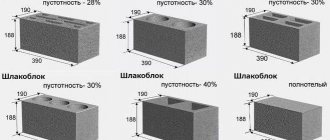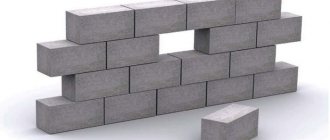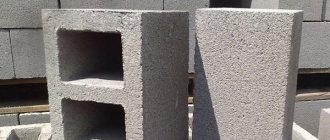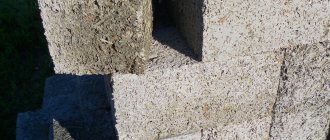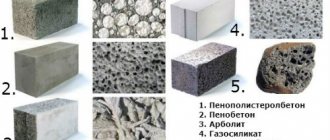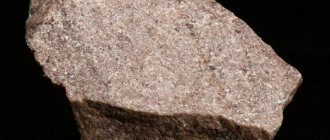You will need
- – tape measure; – sheet of paper; – pencil; – calculator.
Instructions
Determine the size of the cinder blocks you are using. The standard block has dimensions of 390x190x188 mm. There may also be a partition cinder block with dimensions of 390x120x188 mm. If you use a different standard or produce this building material yourself, take preliminary measurements of the product.
Determine the method of laying cinder blocks when constructing the wall of a structure. The thickness of the wall and, accordingly, the material consumption will depend on how you place the stone in the masonry. What matters to you is the edge of the block that will be external when building the wall, since its dimensions will directly affect the consumption of material.
Let's say you intend to build a half-block wall. Calculate the area of the wide face of the block. To do this, multiply the length of the block by the width, for example, 390x190 mm.
You will receive 74100 sq. mm or about 0.074 sq. m.
To calculate the consumption of cinder blocks per square meter of wall, divide the unit by the result obtained, expressed in square meters: 1 / 0.074 = 13.51. Rounding the value, you get 14. This is how many blocks you will need to build one square meter of the wall of the structure.
Let's say you intend to build a garage out of cinder blocks with dimensions of 5x7 m and a height of 2.5 m. Calculate the perimeter of the structure by adding its length and width and multiplying this value by two. You will get: (5 + 7) x 2 = 24 m.
Now find the area of the walls by multiplying the perimeter by the height of the garage: 24 x 2.5 = 60 square meters. m. Subtract the gate area from this value, which, for example, will be: 3.2 x 2.5 = 8.75 square meters.
m. As a result, you will get a result of 51.25 sq. m., which is the area of all the walls of the garage.
Considering the number of blocks per 1 sq. m of the structure, calculate the required material consumption.
To do this, multiply 51.25 by 14. Thus, you will need about 717 cinder blocks to build the walls of the garage. When purchasing material, provide a reasonable reserve in case of defects or possible damage to the blocks during operation.
Video on the topic
Sources:
- how many cinder blocks do you need? How to calculate floor area
Cinder block is an inexpensive and reliable building material.
Its use is usually limited to outbuildings, but there are also residential buildings made of cinder block. Before any construction, the first thing to decide is the calculation of the required amount of materials. Our article will tell you how many cinder blocks are in a square meter and how to optimally calculate the quantity.
Types of building blocks
Building a garage is not particularly difficult.
In addition, this will serve as an excellent training ground for developing construction skills. Cinder blocks are light (hollow) and heavy. All of them are made using the molding method, and if you have a special machine, you can organize the independent production of this building material.
In the production of cinder blocks, sand, crushed stone of different fractions, slag (waste ore residues), as well as cement mortar for coupling are necessarily used. In addition to these “mandatory” ingredients, expanded clay, broken bricks and even sawdust are often added to the mixture. Of course, such a slab will have much less weight, but this is compensated by excellent thermal insulation characteristics.
To lay the foundation of a future building, monolithic blocks, strong and heavy, are used.
They will provide reliable support and will also allow you to significantly save on concrete mortar. Lighter blocks with voids inside are much better suited for building walls. Additional insulating properties are provided by filling the space inside with expanded clay or sawdust.
How to make the right choice
It is also necessary to inquire about the exact composition of the original ingredients and the environmental certificate of suitability for use in residential construction.
It is advisable to familiarize yourself with laboratory test reports and find out strength characteristics such as frost resistance, weather resistance, and water resistance.
An external inspection is required. The product must have the shape of a regular parallelepiped. The dimensions of the edges should not differ by more than 1...2 mm, both on one stone and on any other randomly selected from the proposed batch. Concrete on external surfaces must be smooth, without signs of looseness or imperfection. The voids must be symmetrical and in no case connected to external planes in the form of cavities.
How to calculate material for a garage
To make the necessary calculations, you need to find out more information about this material and its features. Despite the fact that many manufacturers interpret the standards for the manufacture of this product too loosely, quality products are more common on the market than fakes.
It is impossible to check the production stages on your own, but you can verify the reliability of the product using a simple test. To do this, you need to buy one unit of the product and drop it from approximately chest height (one to one and a half meters). A good quality cinder block will remain intact, except for some fraying around the edges.
A defective product will most likely split in half. The testing surface should not be concreted, and the block should not be thrown with force. Only after making sure of the reliable quality of the building material can you begin bulk purchases.
Strip foundation made of blocks
The good thing about constructing a strip foundation is that it reduces the amount of work required.
After constructing the foundation, you can immediately begin the next stages of work. You can build a foundation from blocks of the required sizes. Products of special sizes are also offered, for which you do not need to use special equipment. If you purchase material for work from a trusted manufacturer, whose products comply with GOST standards, then high structural strength is ensured.
You can build a foundation from blocks that include additional additives:
- Crushed stone increases resistance to acidic environments.
- Additives that allow the material to withstand temperature changes.
It is also possible to use a hollow block. But this option is suitable for a one-story wooden house with light loads.
What you need to know before purchasing:
The standard dimensions of one block are 39 centimeters.
By simple calculations, you can determine that the cubic capacity will be 72 units of the product. Depending on the forms used in production, a slight difference in size is allowed. If blocks of different dimensions are needed for the construction of a building, the calculation is based on the cubic capacity. If all products are the same, it is easier to plan based on consumption per square meter. The optimal result is obtained by comparing the two calculation methods. This will allow you to get the most accurate quantity and avoid additional difficulties.
If you know for sure the dimensions of the future garage space, calculating the necessary material will not be difficult. The two methods for calculating cinder blocks are described in more detail below.
Types of blocks and their application
Calculation of the amount of material completes the design stage of the construction of future housing
It is important to correctly determine the priority properties of the blocks so that the construction results live up to the hopes placed on it
Characteristics of the material
The production of building blocks has reached a new level; modification of the composition of the material allows it to be endowed with the necessary properties depending on consumer requests. The use of building blocks for the construction of monolithic frame buildings and low buildings is a justifiably popular solution. A variety of sizes, configurations and properties allow them to be used when equipping prefabricated foundations, for external structures and internal partitions. The properties of the blocks indicate the numerous advantages of the material:
- Construction is carried out in a short time, there is no need to operate special equipment.
- The blocks are characterized by a high level of strength and thermal insulation, which allows significant savings on the purchase of additional insulation.
- Compared to wooden log houses, the process of constructing housing is much easier, and the service life is increased due to the high wear resistance of the blocks.
- The blocks do not require increased insulation from moisture, like wood.
- The lightness of the material relative to brick or reinforced concrete allows you to save on a powerful foundation.
Advice ! The use of special masonry adhesive helps to increase the thermal insulation properties of housing while simultaneously increasing the attractiveness of its appearance.
Product classification
Based on their origin, products are divided into natural and artificial materials. The natural option is much more expensive than factory-produced products. This is due to the costs of mining the rock, its subsequent careful processing and grinding. The most popular solution for using natural materials is decorative finishing of facades. The production of artificial products is based on mixing solutions of various compositions using vibroforming equipment. Depending on the source raw material, the material is endowed with the required density, strength and thermal insulation properties. Artificial blocks for construction are:
- foam concrete;
- aerated concrete or gas silicate;
- expanded clay concrete;
- based on sawdust concrete;
- polystyrene concrete, etc.
The first three types are the most acceptable option for the construction of permanent housing. Each option has undoubted advantages and minor disadvantages. One type is characterized by high thermal insulation properties, but strength indicators are not at a high enough level, and, conversely, with increased strength, frost resistance indicators decrease. If necessary, housing construction is organized using two types of materials so that their qualities complement each other. In any case, all subtypes of lightweight concrete contribute to the formation of a favorable microclimate in the constructed house by creating natural ventilation.
Important ! You can proceed to finishing work immediately upon completion of construction; no time is required for the house to shrink. Blocks intended for housing construction are divided into:
Blocks intended for housing construction are divided into:
- Structural products. The main purpose is the construction of load-bearing walls. This is due to the high strength and thermal conductivity of the products, as well as significant weight. The use of additional insulation is a prerequisite for the operation of residential premises during the cold period.
- Structural and thermal insulation products are optimally suited in low-rise buildings for the construction of load-bearing walls. In terms of quality of strength and thermal insulation, they are at an average level. In the case of seasonal living indoors, this is an ideal option.
- Thermal insulation blocks are intended for walls of frame buildings or internal partitions. Can be used as insulation of external structures. Low thermal conductivity, light weight and low strength are the main characteristic properties of the material.
An ideal option that combines all the necessary qualities in terms of frost resistance, strength, lightness and at an acceptable cost has not yet been developed. Each specific building requires an individual approach when determining the material.
Calculation of material by cubic meters:
- Reference data is an indicator for each wall. It is also calculated by the height, width and length of the building. The results obtained must be added together. When making calculations, do not forget that on two walls it is necessary to remove the volume of connecting corners. The final figure is the required number of blocks, calculated by dividing the total volume by the volume of a unit of material.
When constructing internal partitions, “half” material is often used. This is more expedient, because increased heat retention is not required inside. At the same time, when using the above method, a rather large error is obtained, so it is better to use another method of counting blocks.
Initial data
Step 1: The calculator is designed to calculate any types of building blocks. To begin, set the exact dimensions of the building block without taking into account the masonry joint. Be careful here: set the length, width and height of the block in relation to how the block will lie in the masonry. Next, enter such building parameters as the height of the wall and the total length of the wall along the outer perimeter of the building.
Step 2: Next, specify how the blocks will be stacked. The thickness of future walls directly depends on these data. This can be a structure of half a block (the thickness of the wall will be equal to the width of the block) or a whole block (the thickness of the wall will be equal to the length of the block). Choose the installation method depending on the designed number of storeys of the building, the type of floors and other features of the structure.
Step 3: To make the calculation more accurate, it is necessary to take into account the thickness of the masonry joint, consisting of mortar, or glue and other materials. Sometimes the thickness of horizontal and vertical seams is different.
Step 4: To calculate the masonry mesh, you need to decide how many rows you will lay it in. You don’t have to enter data about it by leaving the “Ignore” option in the column. Or count it, indicating that it lies through the Nth number of rows.
Step 5: Block weight is an optional parameter. But if you want to calculate the approximate weight of the finished walls and the load from the walls on the foundation, then it is still advisable to indicate it. Price is also an optional parameter. Specify it if you want to calculate the total cost of blocks.
Step 6: To take into account the gables of the building, as well as windows, doors and additional openings in the calculations, check the appropriate boxes and set the necessary parameters in the list that appears.
Step 7: After filling in all the fields, click the “Calculate” button. You can print the results obtained or send them by email.
For convenience, it is better to count the various elements of the building separately. For example, external walls and interior partitions may differ both in height and in the way the blocks are laid. In this case, perform two independent calculations.
Calculation of the number of cinder blocks by quadrature:
- The area of the building can be calculated by multiplying the total length of the walls by the average height of the room. This value must be divided by the area of the front part of the block used. The resulting value must be rounded up, and if necessary, add from 1 to 5% of the margin.
Calculating the required number of cinder blocks to build a garage is not so difficult.
To do this, you need a paper plan - a diagram, as well as knowledge of the dimensions of the materials used. The calculation can be carried out in two ways, the results of which must be compared with each other. For the convenience of home craftsmen, Garazhov.Ru has a special online calculator, but an independent calculation will provide more information and also help to put together an overall picture of the future project.
Cinder blocks are lightweight concrete blocks that are ideal for garage construction. The size of one cinder block is 390 by 190 by 188.
An online calculator can help you figure out the approximate number of cinder blocks needed for your building.
We will help you accurately calculate the parameters of building structures!
The program for stairs will help to evaluate the convenience of the structure, determine its safety, and present the structure in the open spaces of the room. More about staircase calculators here.
Operating procedure:
- choose a design;
- indicate the width and height of the opening, the dimensions of the steps and stairs, mm;
- take into account the design features and tick them;
- press the button: Calculate.
After a second, the page summarizes the results. In case of deviations from convenience or safety, solutions are proposed. Additional features: the ability to print the result, visually evaluate the structure in 3D mode, detailed drawings necessary for construction, calculation of building materials and building structures.
Visitors to Perpendicular have the opportunity to use our online building materials calculators for free.
Finding volumes
Construction calculations of the dimensions of a trench, pit, well will help to assess the scope of activity, determine the cost of the service and evaluate cost reduction options.
- In the form provided, you must enter dimensions and indicate prices in a convenient currency used for the region. The calculator of materials for repair or construction summarizes the total cost of the work, in which, in addition to volumes and area, the full cost of the work is described in detail.
- The obtained result can be used both to determine the volume of soil that will need to be removed, and to select an economically feasible option for performing the work.
- Determining the area, volume of pipes, tanks, cylinders, and the size of a land plot are useful every day for solving life problems.
- A program for determining the amount of crushed stone, sand or soil based on the geometric dimensions of the heap will be required to calculate the volumes and assess the resources available to the owner.
How to calculate materials for construction work
- Special programs will help determine the parameters of structures in the manufacture of foundations, greenhouses, and flooring. The accuracy of the result depends on the correctness of the measurement and the entered dimensions in mm. Measurements are taken according to the drawings shown on the website. The building materials consumption calculator provides the result in the form of data on the required quantity and provides general advice on production.
- In relation to the foundation, these are the hardening times; for greenhouses, recommendations are given on creating good thermal insulation; the roof parameters intersect with the data on the choice of angle of inclination. The volume of the resulting attic space is given.
- Using the tools available on the site, visitors to Perpendicular.pro can receive practical advice and accurate data in a matter of seconds. All that is required of you is to take the measurements correctly according to the drawing and enter them into the program cells. Of the special devices, one tape measure is enough.
How to use it
To calculate, you need to fill in all the columns: the length and width of the future garage and the height of the walls. In order not to buy extra blocks, you need to indicate the size of the gates and windows (if the garage is planned for a workshop).
In the calculator you can calculate the number of cinder blocks for the construction of not only a one-story, but a two-story and attic garage.
Cinder blocks can be laid both widthwise and lengthwise. In the first case, the consumption will be greater, but the thickness of the walls will also be greater. Therefore, the column about masonry must also be filled out.
Attention: online calculation does not take into account seams. If you are planning large seams between blocks, subtract 5% from the result.
Cinder block is rightfully considered one of the most popular building materials nowadays. Its superior performance and ease of operation are key factors in its sales growth. The popularity of this building material can also be evidenced by the fact that many people today ask questions, such as how to calculate the amount of cinder block for a wall.
How many foam blocks are in 1 m2?
Answer: For a wall thickness of 20cm, 5.55 foam blocks
size 20x30x60cm by 1 m.
Interesting materials:
How to prepare a weed removal solution? How to prepare a humate solution? How to prepare cement mortar for flowerpots? How to prepare a solution from ash for cucumbers? How to prepare a solution from ash? How to prepare a weed killer solution? How to prepare an ash solution for tomatoes? How to glue an apron to wallpaper in the kitchen? How to glue to tiles? How to glue fallen tiles on the wall?
What properties do cinder blocks have?
By adding perlite or expanded clay, the material becomes as light as possible. If you add sawdust to it, you can also get a fairly fire-resistant option. If cement, crushed stone or sand is added to a cinder block, the material becomes heavy and conducts temperature quite well.
The parameters of these products are as follows:
- Standard dimensions of cinder block - 188x190x390; Frost resistance index - F15-50; Thermal conductivity - 0.27-0.65 watts per square meter; Density - 750-1,450 kilograms per cubic meter; Strength - M35-M125.
Features of calculating vertical parameters
At the first stage, the height of the structure is determined. The depth of the base depends primarily on the average depth of soil freezing.
Soils and subsoil often contain clay. In such soils, water accumulates, which expands when it freezes in winter. If the slabs are shallow, the frozen ground will push them out. In summer, if the soil shrinks unevenly, the foundation strip may crack: the building will become uninhabitable. Soil freezing parameters are indicated in the joint venture “Construction Climatology”. The minimum depth for laying a FBS foundation is selected with a slight excess of this indicator - by 20–30 cm.
Sandy soils belong to the class of low-heaving soils: water does not linger in the sand, freezing has a slight effect on the strength of the foundation and, consequently, on the depth of its laying. However, underground streams can wash sand from underneath the foundation of a home.
In all cases, it is advisable to arrange a sand and gravel bedding under the structure and fill it with 10 cm of concrete on top. This pillow will perform two functions simultaneously:
- drainage system;
- additional soil compactor.
Solid and hollow cinder block
Full-bodied. An extremely durable building material that is used at the most critical stages of construction.
Hollow. The number of voids, depending on the volume, can be 30 or 40 percent.
Can be used for building walls. However, the most hollow options can only be used in conjunction with a metal frame. Otherwise, the strength of the erected structure will be questionable.
Features of transportation of building materials
Before construction begins, the blocks should be delivered to the site
During transportation, special attention is paid to the integrity and preservation of the properties of the cargo. Aerated concrete is a rather fragile material that can be damaged when loading or unloading vehicles.
Pallets must be loaded in one row with a distance of 5 cm between them to avoid collisions. Packages must be securely secured using straps made of soft material. The speed of freight transport should not exceed 70 km/h on an asphalt road and 40 km/h on a road with poor quality. Soft ropes are used for unloading. The unloading itself is done using a crane, one pallet at a time.
Compliance with all requirements during transportation allows you to maintain the quality of the building materialSource storage.bloxy.ru
Benefits of using cinder blocks
Big sizes. Cinder blocks are very easy to lay and construction with their help occurs quite quickly; Cost-effective.
In addition to the affordable price of these products, cinder blocks also require much less mortar to lay the wall; Durability. Another undoubted quality of cinder block, making it extremely attractive. Structures erected with its help can last a very long time; Fire resistance; A variety of fillers makes it possible to select the material for your needs.
Cube of timber 150x150x6000: calculation formula
In turn, to calculate the amount of timber 150x150x6000 in 1 cubic meter, it is necessary to divide 1 m³ by the value that was obtained earlier, that is, by the volume of 1 wooden product. The mathematical formula itself will look like this:
N (pcs.) = 1 m³ / V
The formula with substituted values in finished form in this case will be like this:
1 m³ / 0.135 m³ = 7 pcs.
Thus, the answer to the question of how many pieces of timber 150 150 are in a cube is the number 7. Now all that remains is to find out the price for 1 timber. To do this, you will need to multiply the volume of the block, determined by the first formula, by the cost of 1 cubic meter of wood building material. The approximate price of bars of this volume is 6,500 rubles. Therefore, the finished mathematical expression with the solution will look like this:
0.135 x 6500 rub. = 877.5 rub.
It turns out that the price for 1 beam, the length of which is 6 m, is 877.5 rubles. Determining the cubic capacity of a board and the number of wood products contained in 1 cubic meter is not so difficult. The same mathematical calculation allows you to find out how many pieces there are in a cube of 100x100 timber. Experts recommend using formulas, as they allow you to perform the most accurate calculations. This is because some tables contain rounded values.
To determine the amount of timber in a cube, experts recommend using formulas.
Disadvantages of using cinder block
High temperature conductivity.
In other words, cinder block houses can be cold. But only if you make a mistake with the choice of this material. After all, as we said above, there are many types of cinder blocks, and among them there are also options with low thermal conductivity; High sound permeability.
Partly solved by the correct selection of insulating materials; Hygroscopicity. Cinder block absorbs water very well, so walls made from it require plaster on both sides. In addition, you should not build such houses in places prone to floods or characterized by a very humid climate; Environmental friendliness.
When purchasing cinder blocks, you need to ask the seller about the availability of a safety certificate. It's all about the sulfur and acid content there, which disappears only after a year in the open air. A certificate of environmental safety is given only to such materials; For some, the high strength of a cinder block can become not only an advantage, but also a disadvantage, since in this case it becomes not very convenient to lay communications.
sizes and price per piece
Cinder blocks are considered a reliable and affordable building material. It allows you to build a strong and durable building. Manufacturers offer many size formats at an affordable price. These wall stones are used for the construction of load-bearing and enclosing structures.
Features of choosing cinder block
It is important to know that the price per piece depends primarily on technical characteristics, in particular density. And the last indicator is influenced by the quality of the filler (it can be blast furnace slag, ash, perlite, expanded clay chips)
One standard cinder block with dimensions 390*190*188 is equal in volume to 8 bricks. The product contains cement and binding components - blast furnace slag, ash, sawdust, gravel. Thanks to vibrocompression, they are compacted tightly, and the material comes out with good density. Due to the affordability and ease of masonry, a cinder block bathhouse will not cost too much, and by isolating the room from moisture, you can maintain all the technical characteristics of the products.
According to the standard, they can be full-bodied or 2, 3, 4 hollow. Porosity reaches 28, 30, 40%. Thermal conductivity, frost resistance, and strength depend on the number of cavities (rectangular, slot-shaped, round) and the saturation of the block with pores. The buyer is primarily concerned with the question of how much load the product can withstand. Its density reaches 750-1450 kg/m3. Most often, cinder blocks with a porosity level of 30% are chosen for the construction of walls; they have optimal strength indicators (up to 150 kg per 1 cm²) and the ability to retain heat. An alternative option is standard foam blocks measuring 20x30x60 cm; one product can replace 15 ordinary bricks.
A cinder block garage will be durable and reliable. It can be quickly built with a minimum of cash costs
It is important to build a strong strip and columnar foundation and insulate the external walls. If reinforced concrete slabs are chosen as the floor, it is imperative to install a monolithic belt, otherwise the blocks will not withstand the load
Foreman's advice: the main disadvantages of the material (high hygroscopicity, the need for additional thermal insulation of external walls) can be eliminated by using high-quality waterproofing materials and insulation. In return, the home owner will receive reliable lightweight material at an affordable price.
When buying a cinder block, you must check for a quality certificate. If during production standards were violated and toxic substances (heavy metals, carcinogens) were added, this will not only violate the technical characteristics of the material, but will also harm human health. An important aspect is storage conditions. Products have high hygroscopicity, that is, the ability to absorb moisture, therefore, if you do not protect them from dampness, they will lose their properties and will not provide the necessary strength and warmth in the house. Although the price of blocks made at home is cheaper than factory ones, it is not worth the risk. Products from a trusted supplier can be evaluated, double-checked, and a formal claim can be made in case of defects. In addition, cinder blocks made by yourself will not match the performance of those made using professional equipment, and this directly affects the quality of the product. High-quality blocks are produced only in accordance with state standards.
Photo: cinder block house
Sizes and prices
The standard dimensions of a cinder block are length 390 mm, width 190 mm and height 290 mm. The formation of the price per piece is influenced not only by the quality of the filler, but also by the dimensional parameters and the presence of a decorative surface. How much does it cost? On average, the cost of one product is 21-50 rubles, quite a bit. Wholesale purchases will cost the construction site owner even less.
The larger the particles in the cinder block, the less durable and lighter the product will be.
Size chart
| Types of blocks (GOST 6133-84, 99) | Standard (L) × depth (B) × height (H) | Quantity per cube/price | Approximate price per piece |
| Full-bodied | 390*190*190-240 | 72/2600 | 36 rub. |
| Double-hollow | 388×188×190 | 72/2520 | 35 rub. |
| Three-, four-hollow | 390*190*188 | 72/2300 | 32 rub. |
| Interwall septal | 390*90*188 | 151/2450 | 16 rub. |
| 390*120*188 | 113/2450 | 22 rub. | |
| 400×200x200 | 60/1440 | 24 rub. |
Foreman's advice: to find out how many cinder blocks are in 1 m³, you need to divide the volume of the cube by the volume of the product (this parameter is calculated by the formula V (volume) = L (length) x B (width) x H (height)).
Cinder block, like any other building material, has its pros and cons. But with proper preparation for construction and compliance with masonry technology, the shortcomings will be eliminated, and the building will serve the owner for a long time.
How to calculate the amount of cinder block on a wall
When compared with brick, cinder block immediately stands out for its size.
A standard unit of such building material is equal to as many as five bricks. Above we presented the most popular size (), but there are others different from it - 395 * 195 * 195, 390 * 120 * 188 and 400 * 200 * 200. But these options are much less common.
In this regard, there is a simple calculator that helps you calculate the number of cinder blocks per wall. So, we multiply the width by the length (190X390) and get the area of the wide edge equal to 0.074 square meters.
Dividing one by this number, we find that to build one square meter of wall we will need approximately 14 blocks. Now all that remains is to calculate the total area of the wall, and we will get the number of blocks needed. But it’s better to take it with a reserve - about 10 percent more than necessary.
How to use the online cinder block calculator?
Working with the calculator is extremely simple: you just need to enter four parameters into the appropriate form - the size of the block (from the drop-down menu), the length and height of the walls, as well as the total area of the openings.
The length of the walls is obtained by ordinary folding. For example, for a box 7 by 8 meters - 7+7+8+8=30. The height of the wall is chosen based on personal preferences (the higher, the more comfortable, and the lower, the cheaper). Usually they focus on a height of 2.7 meters.
The sizes of windows and doors are converted into meters and multiplied. For example, for a doorway the area will be 2.0 × 0.8 = 1.6 m2. Having determined the areas of all openings, we add them up and enter them into the form on the website.
Next, click on the “Calculate” button, after which the calculator will display the finished result - the total area of the walls excluding openings, as well as the required number of cinder blocks and their total volume. You can also evaluate the difficulties of transporting and storing building materials.
The calculator makes an estimate of the number of blocks per wall. In reality, you will most likely need to buy more. Firstly, in accordance with GOST, the dimensions of a cinder block can vary within 7.5% of the declared ones (unscrupulous manufacturers underestimate them slightly). Secondly, you need to take into account the margin for a likely fight, because it is inevitable both during transportation and during stowage.
Tips for Building with Cinder Block
Since this material gets wet very well, it is better to try to raise the foundation above the ground. As for the base, it needs to be well insulated; The ideal and simplest insulation for cinder block walls is a semi-liquid solution of cement and sand.
We spray this “coat” on the walls using a large brush. After the first layer has dried, it is best to apply the second; The appearance of the cinder block is quite unsightly, so you need to take care of the exterior finish. For this, siding or decorative brick can be used; If you want to achieve environmental friendliness, moisture resistance, as well as high insulating properties, then it is best to use expanded clay concrete.
In it, slag is replaced with expanded clay, which significantly changes the properties of this building material; Many cinder blocks are made in a handicraft manner, since the raw materials for them are cheap, the manufacturing technology is simple, and brick presses are relatively affordable. It is not possible to check the quality of such products and what they are made of. So, it is best to buy cinder blocks from large sellers.
In what cases and how is a construction calculator used?
To properly use an online construction calculator, you need to clearly understand its pros and cons. At the same time, first of all you have to focus on the shortcomings:
- Lack of flexibility. Any calculator makes calculations solely based on its built-in templates and formulas. If you need to calculate data for which the calculator is not provided, then you won’t be able to reconfigure it and you will have to do everything manually.
- Low transparency of calculations. Even if the calculator contains exact formulas, the user has no way to check what exactly and how correctly he thinks, since everything is hidden behind the user interface intended exclusively for entering primary data.
Behind the user interface, the formulas by which the calculations are performed are not visible - only the initial data and the resultSource nkkconsult.ru
Despite such significant disadvantages, various construction calculators are still very popular - this is due to the following positive aspects:
Based on the initial data that the calculator requires, you can still imagine the progress of the calculations and what to look for when choosing a project or communicating with the specialists who will perform the work. Based on the results generated by the calculator, you can compare the cost of work with different materials or compare the price of houses built using different technologies.
At the same time, it is not recommended to use a building materials calculator for building a house for any precise calculations, since it is often unknown what formulas and with what tolerances the calculations are made.
Option 1 - a wall as thick as half a block or 190 mm
Wall as thick as half a block
Knowing that the height of the cinder block is 188 mm and the length is 390 mm, its lateral area is calculated (after converting all values to the SI system):
Slateral surface = 0.188 * 0.39 = 0.073 sq. m.
Now, knowing the area of one block, you can calculate how many blocks will be needed to build 1 square meter. m. walls.
Nblocks in 1m2=1/0.073=13.64 pcs.
The resulting value is slightly larger than the actual value, since we did not take into account the thickness of the mortar joint.
If we take into account the seam thickness of 8–10 mm, then in reality we will need not 13.64 pieces, but exactly 13 pieces.
Block calculation calculator - calculation rules and initial data
Before starting calculations, you should decide which method will be used to calculate the number of blocks.
The following calculation methods are possible:
- manual calculation. To determine the need for material, you should use standard formulas known from school;
- calculating the number of blocks using an online calculator. It guarantees the accuracy of the calculations made and increased calculation speed.
By correctly determining the amount of material required, you will protect yourself from the costs of additional delivery of missing products or unreasonable surpluses. When performing calculations, the wall and partition block calculator takes into account the following data:
- type of block composite used for construction;
- dimensions of building materials;
- specific gravity of the block;
- the total length of the building walls;
- height of main walls and partitions;
- thickness of load-bearing and internal walls;
- thickness of the binder solution layer;
- frequency of installation of masonry mesh;
- number of window and door openings;
- number of gables and their sizes.
Using the calculator posted on the website, it is easy to calculate the number of blocks on your own
To obtain an accurate result, it is important to correctly enter the material parameters and the thickness of the masonry mortar. An easy-to-use wall block calculator will not only professionally calculate sand block, cinder block or other block composite, but also determine the volume of mortar required for laying the walls of the building
Option 2 - a wall one block or 390mm thick
A wall as thick as a block
The calculation algorithm is the same.
Slateral surface = 0.188 * 0.19 = 0.036 sq. m.
Nblocks in 1m2=1/0.036=27.99 pcs.
And taking into account the mortar joint, we will need 26 pieces of whole blocks.
This is the initial stage of calculations. To find out a more accurate quantity and consumption of building materials for the project, you need an estimate for construction work, that is, you need to calculate how many cinder blocks may be needed to build the entire house.
The total scope of work determines the total cost of the object, which consists of:
- 30% - foundation, concrete mortar (adding cement, sand, water, slag aggregates), reinforcement frame, excavation work. 45–50% - object walls, including load-bearing structures and lintels. 20–25% - roofing.
Let's assume that the entire volume of construction work will be based on the use of cinder blocks - the construction of a foundation, walls and partitions.
To calculate the number of products pressing on the foundation, you need to know the weight of the load-bearing wall, which depends on the type of cinder blocks used. These can be either solid or slotted blocks. Their weight varies from 11 to 28 kg.
Number of slag concrete blocks in one cube
Cinder block is a wall stone made from solid fuel formations obtained as a result of combustion. Expanded clay, crushed stone, brick fragments, and sawdust are used in production. The technology consists of preparing a solution with the addition of clay and water and compacting it using vibration, after which the mixture is loaded into molds until complete hardening, which lasts about a month.
Calculation formula
When building a house from wall stone, the question often arises of how to correctly calculate how much cinder block is in 1 cubic meter. An accurate calculation will help determine the amount of material and minimize construction costs. Therefore, engineers use the existing formula:
1. The easiest way to start the calculation is with the standard size of a cinder block. This is 390x188x190 mm - length (L), height (H) and width (B), the volume is marked with the letter V.
2. To find out the required value, you will need to multiply three parameters. The result will be 390x190x188=13930 cm3.
3. The volume of a cubic meter unit is 1,000,000 cm3. Now you can calculate how many blocks there are in one cube by dividing the total figure by the value of a unit of stone: 1,000,000: 13930 = 71.78, round up and get 72 pieces.
It is necessary to take into account that the length of the cinder block is not a multiple of the same parameter of the cube, so 20% less material will fit. When making calculations, some experts add the distance between units during laying, this is approximately 5 mm per side, excluding the height, as shown by the following formula: (L+5)xHx(B+5), which in numbers will be (390+5) x188x(190+5)=395x188x195=14480700 mm or 0.0144807. As a result, in one cubic meter there are 1,000,000: 0.0144807 = 70 pieces.
Varieties
Since cinder blocks are used for different tasks, it is important to consider other dimensions. With the same input data for the width, length and height of the semi-blocks, the initial void figure changes; it varies from 28 to 40%, which affects the strength, heat and sound insulation indicators
Therefore, when making calculations you need to know certain nuances:
1. The weight of the wall stone is noted to be between 25 and 28 kg. In production, cinder blocks with dimensions of 400x200x200 and 395x195x195 are produced.
2. Hollow materials are purchased for arranging load-bearing structures. Their weight varies between 18-23 kg.
3. For interior partitions, a half-block is suitable, which has a voidness parameter taken into account in the calculation. Applying the basic formula, you can understand that with an indicator of 30% you will need 92 pieces, and for 40% - 99, provided that standard sizes are used. The weight of this stone is 10-13 kg.
4. The strength grade also plays a role. For the construction of walls and interior work, the M35-M75 block is used, and the construction of the foundation involves M125-M200.
5. The integrity of the material is of great importance, so when choosing, you need to check the geometry and the absence of defects. Experts recommend comparing several pieces to make sure there is a slight deviation from the norm. It is better to make a one-time purchase from one batch, this will ensure an acceptable discrepancy.
How much does it cost to lay a block per square meter?
The cost of laying expanded clay concrete blocks averages 1,500 rubles per cubic meter. Such blocks are popular in our area.
Interesting materials:
What lengths of eyelashes are there? What days are favorable for cutting hair? What documents are needed for a money transfer? What documents are needed to apply for a dairy kitchen? What documents are needed to apply? What documents are needed when refinancing a loan? What documents do auditors require? What attractions are located in Eurasia? Which firewood is better, acacia or oak? What factors influence climate formation?
Quick calculation of volumes of building materials!
| Perpendicular.pro offers professional construction calculators for calculating the necessary materials and their consumption during construction. | The cost of building a house and performing repairs directly depends on the amount of concrete, reinforcement, lumber, sand, and crushed stone. To obtain values, you will need calculating devices and special formulas from the school course, some of which have been erased from memory over the years. |
|
How much should a cinder block weigh?
How much does one cube of cinder block weigh?
| cinder block | Weight of one block, kg | Weight of one cube, kg |
| Full-bodied | 20 | 1440 |
| Hollow | 11 | 792 |
| Standard four-slot | 13,5 | 972 |
| Thickened four-slot | 15 | 1080 |
Interesting materials:
What were combinations worn for? What is code 95 for? Why do you need an aquarium in the house? Why do you need a blacklist in contact? Why do you need Eco mode in a washing machine? Why do you need an air ionizer? What is a hash tag for? What is the Klyachka eraser used for? What is a mesh for? Why do you need a VGA to DVI adapter?
